Wednesday, 21 July 2010: Tournai en fête
Written 28 July 2010
Over breakfast the next morning (the usual assortment of cereals, fresh fruit salad, yogurt, soy yogurt, sliced bread (with toaster), fresh whole fruit, ham, salami, cheeses, baguettes, and pastries), while David slumbered on, I made the acquaintance of the gracious, vivacious, loquacious Christine Jackson, transpersonal psychotherapist/spiritual healer from Lincolnshire. We initially spoke French to each other until we realized we were both native English speakers! Within 10 minutes of our meeting, she had devined, with the help of a tiny pendulum she carries with her for the purpose, that I had some Russian and perhaps even Jewish ancestry (of which I was entirely unaware), about four generations back. She used to live in Belgium, and has just returned, intending to settle in Tournai. She was fascinated by the concept of "meiobenthology," wrote the word down so as not to forget it, and made the innkeeper learn it, too, when he came by to bring us our coffee. We're both morning people, and we swapped morning stories. Apparently in her younger days, when she travelled with older male colleagues on business, they made her sit at a different table at breakfast because they couldn't cope with someone so cheerily, chirpily chatty so early in the day!
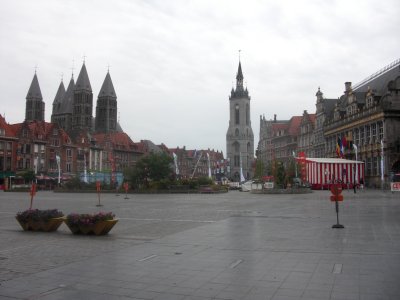
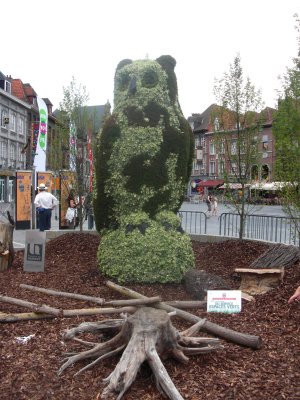 After David came down and had breakfast, we set off to explore the town, and as we turned the corner into the Grande Place, we found that David had gotten his wish! All the cars were gone, the traffic had been diverted, and the entire space was almost as open as it was originally intended to be. July 21 is Belgium's national holiday, and the decks had been cleared for festivity! Beyond the place, at the far end, you can see the cathedral's five towers and the town's belfry. We weren't quite in time to get the idea photo, as the striped tent over the concert stage had already been erected in front of the town hall, but we got it before the bouncy castles were set up, and the four-sided bungee-bouncer, the bumper cars, and the tent where exercise equipment was being demonstrated and kick-boxing lessons being given were all behind us.
After David came down and had breakfast, we set off to explore the town, and as we turned the corner into the Grande Place, we found that David had gotten his wish! All the cars were gone, the traffic had been diverted, and the entire space was almost as open as it was originally intended to be. July 21 is Belgium's national holiday, and the decks had been cleared for festivity! Beyond the place, at the far end, you can see the cathedral's five towers and the town's belfry. We weren't quite in time to get the idea photo, as the striped tent over the concert stage had already been erected in front of the town hall, but we got it before the bouncy castles were set up, and the four-sided bungee-bouncer, the bumper cars, and the tent where exercise equipment was being demonstrated and kick-boxing lessons being given were all behind us.
Other features of the place were this splended 12-foot topiary owl (sponsored by the "Department of Green Spaces"; I don't know whether he's permanent or was just there for the festival), a series of fountains that erupt right from the pavement in which children were happily spashing, and a monumental statue of a wild-haired woman in long skirts and armor breastplate striding forward gesturing expansively. The inscription translates "The city of Tournai to Christine de la Laing, Princess of Espinoy, siege of 1581." We never did get the story behind that. The town displayed a lot of statues—some historic like the princess but most artistic—some of which commemorated painter Rogier van der Weyden (1400-1464), who was born in Tournai. He painted lots of Art 100 stuff; just Google him for a selection of images.
A fortunate effect of the holiday was that we parked free for our entire stay in Tournai—we arrived in late afternoon, after parking enforcement ended for the day, parking was free on the holiday, and we left before enforcement started on Thursday. An unfortunate effect was that the tourist office was closed, so we didnt' get to do the walking tour with audioguides. The cathedral and other churches were open, though, and many full-text historical markers had been set up around town, so we had plenty to see and do.
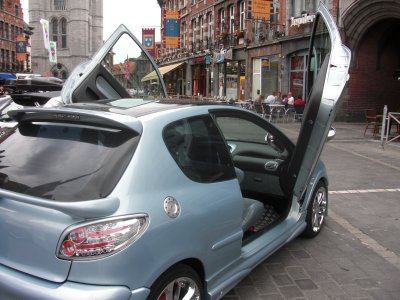
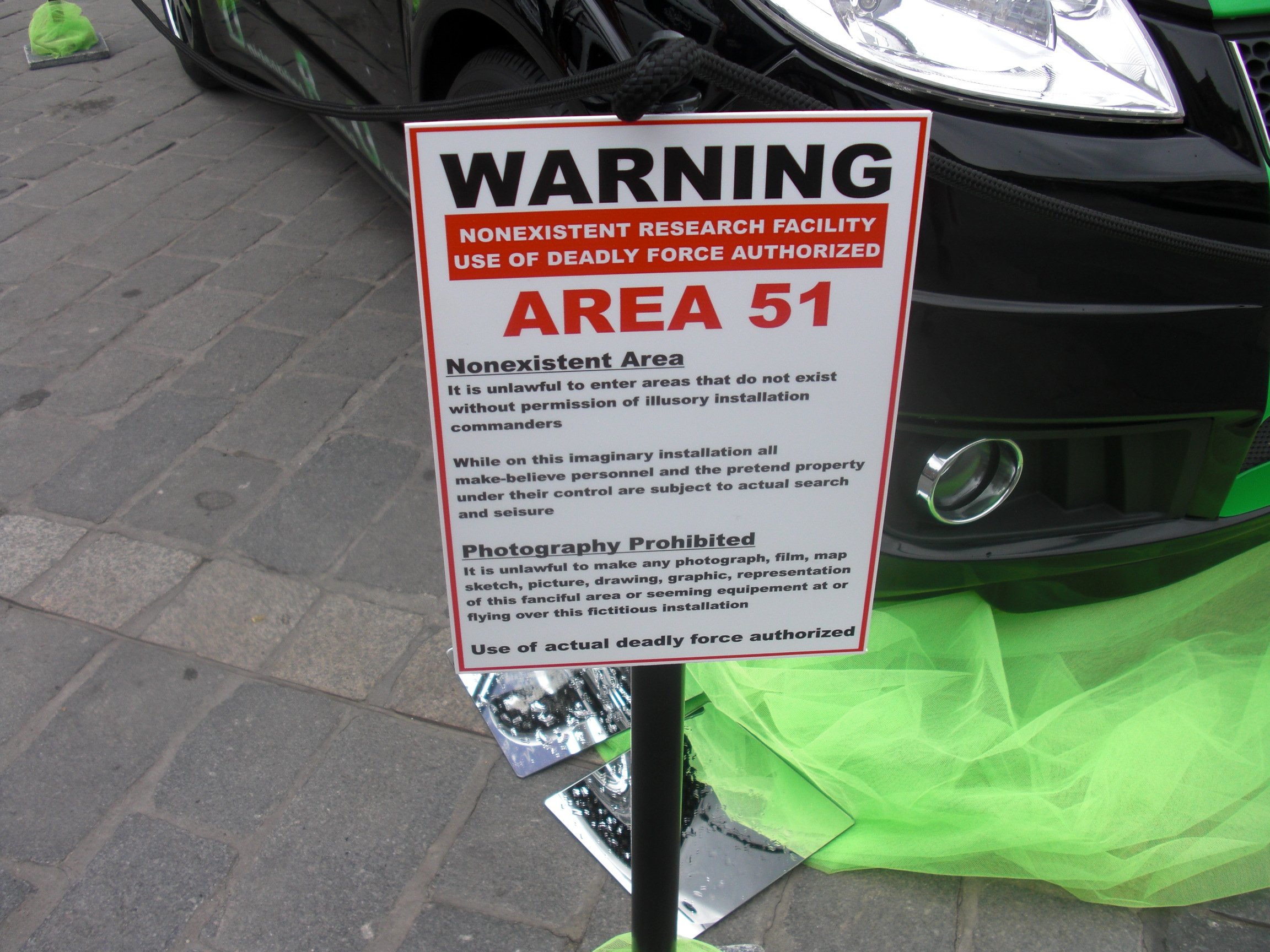 At the far end of the square, on our way to the cathedral, we encountered a hilarious display of "American cars," actually little bitty European cars tricked out as low riders, some with about 1" clearance from the ground— less than the irregularities in the stone paving, so they must have had to take the skirts off just to get them into position on the square! This one's only modification was its amazing batwing doors. My favorite was this warning sign, in English, which starts out "Warning: nonexistent research facility . . . " and continues in smaller print, "It is unlawful to enter areas that do not exist without permission of illusory installation commanders," etc. etc. The car behind it was manned by an inflatable alien of the standard "green man with bulbous head and slanted eyes" configuration.
At the far end of the square, on our way to the cathedral, we encountered a hilarious display of "American cars," actually little bitty European cars tricked out as low riders, some with about 1" clearance from the ground— less than the irregularities in the stone paving, so they must have had to take the skirts off just to get them into position on the square! This one's only modification was its amazing batwing doors. My favorite was this warning sign, in English, which starts out "Warning: nonexistent research facility . . . " and continues in smaller print, "It is unlawful to enter areas that do not exist without permission of illusory installation commanders," etc. etc. The car behind it was manned by an inflatable alien of the standard "green man with bulbous head and slanted eyes" configuration.
Written 30 July 2010
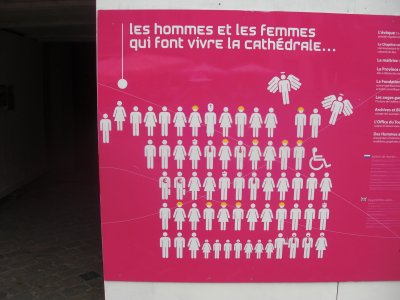 The cathedral was (is and will be for some time to come) under serious repair, reconstruction, and archeological investigation. Whole sections of it were fenced off, scaffolding was everywhere both outside and in, about a quarter of the floor of the nave had been excavated to reveal the foundations of the earliest churches on the site, and signs reminded the visitor, "Quiet and respect, please; you're in a sacred place even if it is a shambles just now." While we waited outside for the doors to open for the day, we got to study this enchanting chart of "the men and women who make the cathedral live." Besides the bishop (recognizable in his tall mitre in the top row), it shows men and women of all kinds. Some wear hard hats, a few wear ties, two carry briefcases and are marked with euro signs, one is in a wheelchair, two are flying away as angels (posthumous donors?). In the bottom row are children (and three adults) with open singing mouths, accompanied by a man holding a baton. Wonderful.
The cathedral was (is and will be for some time to come) under serious repair, reconstruction, and archeological investigation. Whole sections of it were fenced off, scaffolding was everywhere both outside and in, about a quarter of the floor of the nave had been excavated to reveal the foundations of the earliest churches on the site, and signs reminded the visitor, "Quiet and respect, please; you're in a sacred place even if it is a shambles just now." While we waited outside for the doors to open for the day, we got to study this enchanting chart of "the men and women who make the cathedral live." Besides the bishop (recognizable in his tall mitre in the top row), it shows men and women of all kinds. Some wear hard hats, a few wear ties, two carry briefcases and are marked with euro signs, one is in a wheelchair, two are flying away as angels (posthumous donors?). In the bottom row are children (and three adults) with open singing mouths, accompanied by a man holding a baton. Wonderful.
Inside, in a side chapel, was a Reubens portraying the deliverance of souls from purgatory. No way to get a photo that did it justice. Around the sides, near the construction and excavation areas, were many charts, diagrams, and explanations of what was being done, as well as demonstration items like a section of the old leading currently being replaced on the roof.
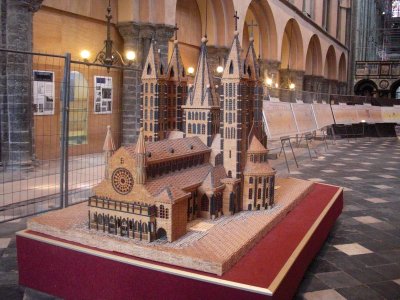
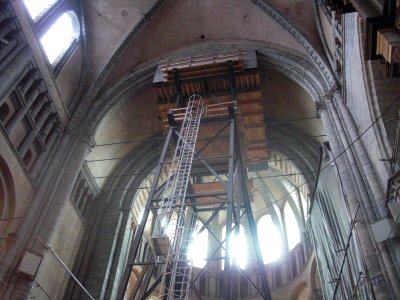 This wooden model (which seems to be made mostly of something like lincoln logs) gives a better idea of the building's appearance than a photo would, because so much of the exterior is covered with scaffolding. The photo at the right shows some of the indoor scaffolding—a sort of wooden hut held up against the vaulting of one of the transcepts on four tall wooden legs. No one was working when we were there, because of the holiday.
This wooden model (which seems to be made mostly of something like lincoln logs) gives a better idea of the building's appearance than a photo would, because so much of the exterior is covered with scaffolding. The photo at the right shows some of the indoor scaffolding—a sort of wooden hut held up against the vaulting of one of the transcepts on four tall wooden legs. No one was working when we were there, because of the holiday.
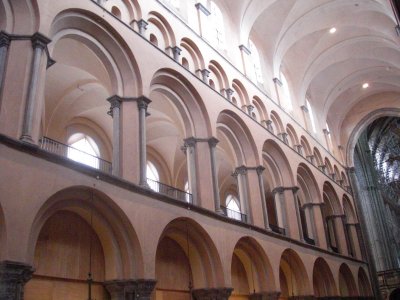
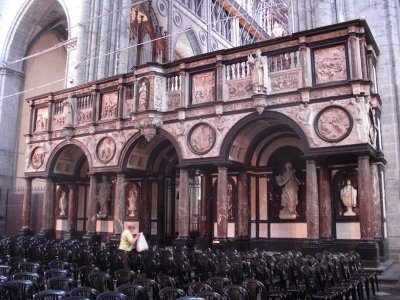 Some section had already been finished—on the left, a section of the wall and vaulting of the nave; on the right the gorgeous screen that separated the nave from the choir. (In this cathedral, the choir was almost as long as the nave and was ornamented by elaborate wood carvings.)
Some section had already been finished—on the left, a section of the wall and vaulting of the nave; on the right the gorgeous screen that separated the nave from the choir. (In this cathedral, the choir was almost as long as the nave and was ornamented by elaborate wood carvings.)
Written 31 July 2010
After a visit to the cathedral treasury (more incredible silver and gold statuary and reliqueries) and an omelette lunch of no great distinction (during which we watched the bouncy castles arrive and get inflated—four of them), we went on to visit the nearby churches of St. Jacques and St. Quentin. St. Jacques was constructed (in the 13th century) specifically to receive (house, feed, otherwise succor) pilgrims on their way to Santiago de Campostella, so of course brass scallop shells set in the sidewalks lead to and from it (although on none of our travels this year did we actually see a single pilgrim; we know from our visit to the place in 2005 that droves of pilgrims arrive there on foot every day, but this far out, they seem to be spread rather thin). If St. Quentin (also 13th century) was built for a particular purpose, I missed it. It its choir on the platform with the altar but off to one side was a strange black container, about the size of a party beer keg, raised about a foot off the floor on three black iron legs. It had a stylized eagle painted on it and a little brass spigot at the bottom. For dispensing holy water? We never figured it out.
Back at the hotel, while we rested our feet, David ran the TV channels and hit on a terrific brass-band festival. The band that was playing when we first tuned in was Belgian, so we assumed the festival was a propos of the holiday, but no—it was taking place in Rennes, in Normandy, in the same square where we once caught a concert by a group on its way back from the Celtic music festival in Lorient. The Italian Bersiglieri were there (we saw them in 2005 at the Menton lemon festival; they don't just march while playing, they run!), as were many other excellent bands. A great concert.
We had dinner at Charles Quint, again in the Grande Place. (Charles Quint, 1500-1558, was the heir of the Hapsburgs, the Valois kings of France, Dukes of Burgundy, and the rulers of Castile-Leon & Aragon, so he became king of everything in sight as well as Holy Roman Emperor; he was a contemporary of Henry VIII and Elizabeth I.) "Charles Quint" is also the name of a popular Belgian beer, so finding the restaurant named "Charles Quint" was a little tricky, among all the others whose café umbrellas and sidewalk fencing were just as prominently emblazoned with the name.
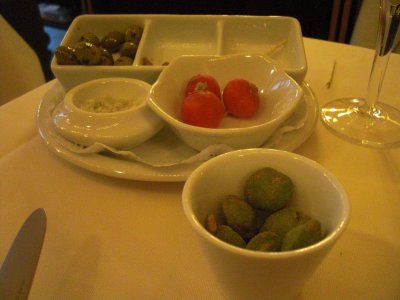
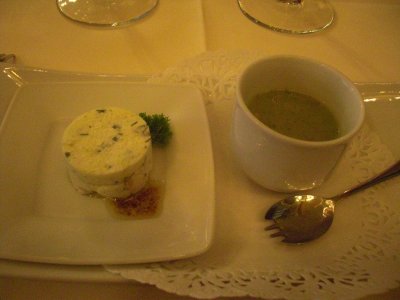 The first amuse-bouche, while we looked at the menus, consisted of assorted olives (a very common choice in this part of the world), a bowl of radishes with coarse salt for dipping, and a dish of the absolutely outstanding wasabi-encrusted almonds (gotta find a source for those; they beat wasabi peas all hollow!). The second, after we ordered, as a cup of chilled zucchini-mint soup and a little timbale of ricotta "aux fines herbes." Both very tasty.
The first amuse-bouche, while we looked at the menus, consisted of assorted olives (a very common choice in this part of the world), a bowl of radishes with coarse salt for dipping, and a dish of the absolutely outstanding wasabi-encrusted almonds (gotta find a source for those; they beat wasabi peas all hollow!). The second, after we ordered, as a cup of chilled zucchini-mint soup and a little timbale of ricotta "aux fines herbes." Both very tasty.
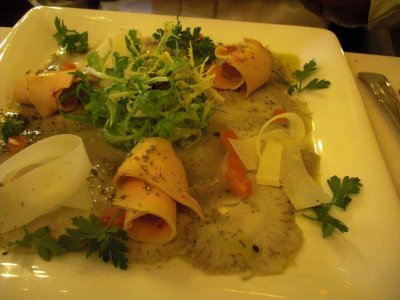
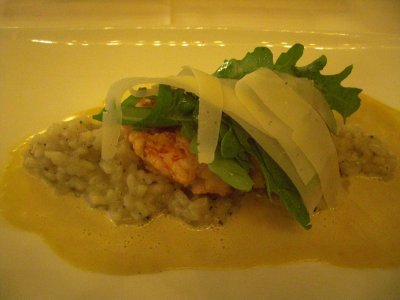 David started with carpaccio of artichokes—paper-thin slices of cooked artichoke bottom fanned on a large plate and garnished with thin, rolled slices of foie gras, thin shavings of Parmesan, a little salad, a sprinkling of diced tomato, and vinaigrette. I had sautéed langoustine tails on a bed of truffle-studded risotto, topped with arugula, surrounded with truffle emulsion, and also garnished with Parmesan. Both excellent! The truffle flavor was subtle but definitely there—a deep earthy mushroom note.
David started with carpaccio of artichokes—paper-thin slices of cooked artichoke bottom fanned on a large plate and garnished with thin, rolled slices of foie gras, thin shavings of Parmesan, a little salad, a sprinkling of diced tomato, and vinaigrette. I had sautéed langoustine tails on a bed of truffle-studded risotto, topped with arugula, surrounded with truffle emulsion, and also garnished with Parmesan. Both excellent! The truffle flavor was subtle but definitely there—a deep earthy mushroom note.
David's main course was sole meunière, but he let the waiter bone it for him, with the result that the lovely fish, displayed to us sizzling in its butter, was brought back in the form of four disembodied filets on a dry plate. At least they gave him a lemon wedge. I had calf's liver with sweet confit onions. Both were delicious but neither especially photogenic.
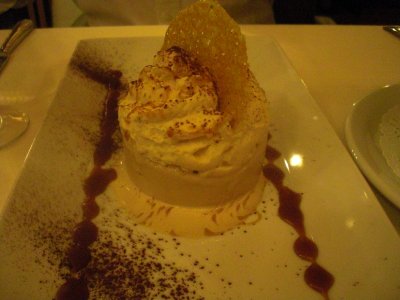 For dessert, we split a cylinder of excellent house-made salted-caramel ice cream, served with whipped cream on a plate decorated with salted-caramel syrup. Yum!
For dessert, we split a cylinder of excellent house-made salted-caramel ice cream, served with whipped cream on a plate decorated with salted-caramel syrup. Yum!
As we walked around the place after dinner, a DJ was at work on the temporary stage (with volunteer dancers from the audience), and the bouncy castles had folded their tents and gone home. We debated staying up another hour for the fireworks (we could see them being set up in the space where the bouncy castles had been) but decided against it. We certainly heard them though! Our window was facing the wrong way but the flashes lit up our hotel's courtyard (just a couple blocks from the place), and I could see the colors reflected off the weathervane atop St. Jacques. When the French do fireworks, they don't believe in this boom, ooh-aah, wait-for-the-next business—they do 45 solid minutes of machine-gun fireworks, simultaneous, overlapping, and loud!
previous entry
List of Entries
next entry

 After David came down and had breakfast, we set off to explore the town, and as we turned the corner into the Grande Place, we found that David had gotten his wish! All the cars were gone, the traffic had been diverted, and the entire space was almost as open as it was originally intended to be. July 21 is Belgium's national holiday, and the decks had been cleared for festivity! Beyond the place, at the far end, you can see the cathedral's five towers and the town's belfry. We weren't quite in time to get the idea photo, as the striped tent over the concert stage had already been erected in front of the town hall, but we got it before the bouncy castles were set up, and the four-sided bungee-bouncer, the bumper cars, and the tent where exercise equipment was being demonstrated and kick-boxing lessons being given were all behind us.
After David came down and had breakfast, we set off to explore the town, and as we turned the corner into the Grande Place, we found that David had gotten his wish! All the cars were gone, the traffic had been diverted, and the entire space was almost as open as it was originally intended to be. July 21 is Belgium's national holiday, and the decks had been cleared for festivity! Beyond the place, at the far end, you can see the cathedral's five towers and the town's belfry. We weren't quite in time to get the idea photo, as the striped tent over the concert stage had already been erected in front of the town hall, but we got it before the bouncy castles were set up, and the four-sided bungee-bouncer, the bumper cars, and the tent where exercise equipment was being demonstrated and kick-boxing lessons being given were all behind us.
 At the far end of the square, on our way to the cathedral, we encountered a hilarious display of "American cars," actually little bitty European cars tricked out as low riders, some with about 1" clearance from the ground— less than the irregularities in the stone paving, so they must have had to take the skirts off just to get them into position on the square! This one's only modification was its amazing batwing doors. My favorite was this warning sign, in English, which starts out "Warning: nonexistent research facility . . . " and continues in smaller print, "It is unlawful to enter areas that do not exist without permission of illusory installation commanders," etc. etc. The car behind it was manned by an inflatable alien of the standard "green man with bulbous head and slanted eyes" configuration.
At the far end of the square, on our way to the cathedral, we encountered a hilarious display of "American cars," actually little bitty European cars tricked out as low riders, some with about 1" clearance from the ground— less than the irregularities in the stone paving, so they must have had to take the skirts off just to get them into position on the square! This one's only modification was its amazing batwing doors. My favorite was this warning sign, in English, which starts out "Warning: nonexistent research facility . . . " and continues in smaller print, "It is unlawful to enter areas that do not exist without permission of illusory installation commanders," etc. etc. The car behind it was manned by an inflatable alien of the standard "green man with bulbous head and slanted eyes" configuration. The cathedral was (is and will be for some time to come) under serious repair, reconstruction, and archeological investigation. Whole sections of it were fenced off, scaffolding was everywhere both outside and in, about a quarter of the floor of the nave had been excavated to reveal the foundations of the earliest churches on the site, and signs reminded the visitor, "Quiet and respect, please; you're in a sacred place even if it is a shambles just now." While we waited outside for the doors to open for the day, we got to study this enchanting chart of "the men and women who make the cathedral live." Besides the bishop (recognizable in his tall mitre in the top row), it shows men and women of all kinds. Some wear hard hats, a few wear ties, two carry briefcases and are marked with euro signs, one is in a wheelchair, two are flying away as angels (posthumous donors?). In the bottom row are children (and three adults) with open singing mouths, accompanied by a man holding a baton. Wonderful.
The cathedral was (is and will be for some time to come) under serious repair, reconstruction, and archeological investigation. Whole sections of it were fenced off, scaffolding was everywhere both outside and in, about a quarter of the floor of the nave had been excavated to reveal the foundations of the earliest churches on the site, and signs reminded the visitor, "Quiet and respect, please; you're in a sacred place even if it is a shambles just now." While we waited outside for the doors to open for the day, we got to study this enchanting chart of "the men and women who make the cathedral live." Besides the bishop (recognizable in his tall mitre in the top row), it shows men and women of all kinds. Some wear hard hats, a few wear ties, two carry briefcases and are marked with euro signs, one is in a wheelchair, two are flying away as angels (posthumous donors?). In the bottom row are children (and three adults) with open singing mouths, accompanied by a man holding a baton. Wonderful.
 This wooden model (which seems to be made mostly of something like lincoln logs) gives a better idea of the building's appearance than a photo would, because so much of the exterior is covered with scaffolding. The photo at the right shows some of the indoor scaffolding—a sort of wooden hut held up against the vaulting of one of the transcepts on four tall wooden legs. No one was working when we were there, because of the holiday.
This wooden model (which seems to be made mostly of something like lincoln logs) gives a better idea of the building's appearance than a photo would, because so much of the exterior is covered with scaffolding. The photo at the right shows some of the indoor scaffolding—a sort of wooden hut held up against the vaulting of one of the transcepts on four tall wooden legs. No one was working when we were there, because of the holiday.
 Some section had already been finished—on the left, a section of the wall and vaulting of the nave; on the right the gorgeous screen that separated the nave from the choir. (In this cathedral, the choir was almost as long as the nave and was ornamented by elaborate wood carvings.)
Some section had already been finished—on the left, a section of the wall and vaulting of the nave; on the right the gorgeous screen that separated the nave from the choir. (In this cathedral, the choir was almost as long as the nave and was ornamented by elaborate wood carvings.)
 The first amuse-bouche, while we looked at the menus, consisted of assorted olives (a very common choice in this part of the world), a bowl of radishes with coarse salt for dipping, and a dish of the absolutely outstanding wasabi-encrusted almonds (gotta find a source for those; they beat wasabi peas all hollow!). The second, after we ordered, as a cup of chilled zucchini-mint soup and a little timbale of ricotta "aux fines herbes." Both very tasty.
The first amuse-bouche, while we looked at the menus, consisted of assorted olives (a very common choice in this part of the world), a bowl of radishes with coarse salt for dipping, and a dish of the absolutely outstanding wasabi-encrusted almonds (gotta find a source for those; they beat wasabi peas all hollow!). The second, after we ordered, as a cup of chilled zucchini-mint soup and a little timbale of ricotta "aux fines herbes." Both very tasty.
 David started with carpaccio of artichokes—paper-thin slices of cooked artichoke bottom fanned on a large plate and garnished with thin, rolled slices of foie gras, thin shavings of Parmesan, a little salad, a sprinkling of diced tomato, and vinaigrette. I had sautéed langoustine tails on a bed of truffle-studded risotto, topped with arugula, surrounded with truffle emulsion, and also garnished with Parmesan. Both excellent! The truffle flavor was subtle but definitely there—a deep earthy mushroom note.
David started with carpaccio of artichokes—paper-thin slices of cooked artichoke bottom fanned on a large plate and garnished with thin, rolled slices of foie gras, thin shavings of Parmesan, a little salad, a sprinkling of diced tomato, and vinaigrette. I had sautéed langoustine tails on a bed of truffle-studded risotto, topped with arugula, surrounded with truffle emulsion, and also garnished with Parmesan. Both excellent! The truffle flavor was subtle but definitely there—a deep earthy mushroom note. For dessert, we split a cylinder of excellent house-made salted-caramel ice cream, served with whipped cream on a plate decorated with salted-caramel syrup. Yum!
For dessert, we split a cylinder of excellent house-made salted-caramel ice cream, served with whipped cream on a plate decorated with salted-caramel syrup. Yum!